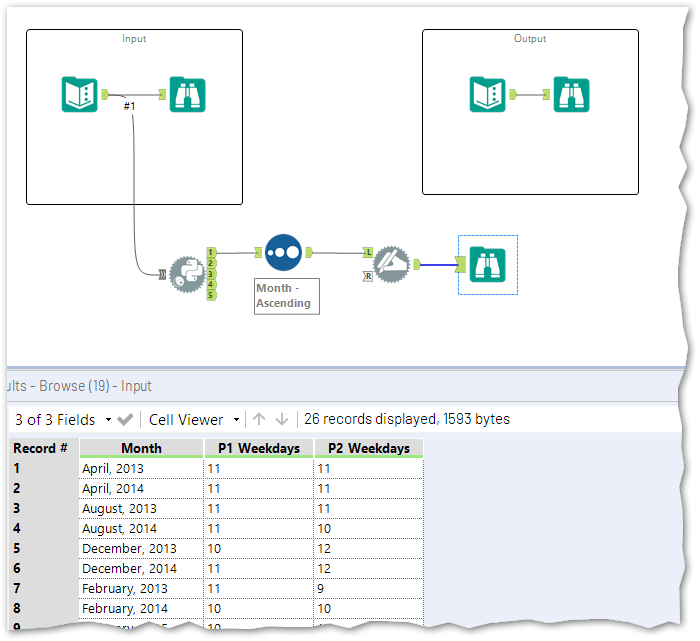Weekly Challenges
Solve the challenge, share your solution and summit the ranks of our Community!Also available in | Français | Português | Español | 日本語
IDEAS WANTED
Want to get involved? We're always looking for ideas and content for Weekly Challenges.
SUBMIT YOUR IDEA- Community
- :
- Community
- :
- Learn
- :
- Academy
- :
- Challenges & Quests
- :
- Weekly Challenges
- :
- Challenge #41: Analytics PayPeriodCalc
Challenge #41: Analytics PayPeriodCalc
- Subscribe to RSS Feed
- Mark Topic as New
- Mark Topic as Read
- Float this Topic for Current User
- Bookmark
- Subscribe
- Mute
- Printer Friendly Page
- Mark as New
- Bookmark
- Subscribe
- Mute
- Subscribe to RSS Feed
- Permalink
- Notify Moderator
- Mark as New
- Bookmark
- Subscribe
- Mute
- Subscribe to RSS Feed
- Permalink
- Notify Moderator
- Mark as New
- Bookmark
- Subscribe
- Mute
- Subscribe to RSS Feed
- Permalink
- Notify Moderator
- Mark as New
- Bookmark
- Subscribe
- Mute
- Subscribe to RSS Feed
- Permalink
- Notify Moderator
- Mark as New
- Bookmark
- Subscribe
- Mute
- Subscribe to RSS Feed
- Permalink
- Notify Moderator
- Mark as New
- Bookmark
- Subscribe
- Mute
- Subscribe to RSS Feed
- Permalink
- Notify Moderator
- Mark as New
- Bookmark
- Subscribe
- Mute
- Subscribe to RSS Feed
- Permalink
- Notify Moderator
- Mark as New
- Bookmark
- Subscribe
- Mute
- Subscribe to RSS Feed
- Permalink
- Notify Moderator
- Mark as New
- Bookmark
- Subscribe
- Mute
- Subscribe to RSS Feed
- Permalink
- Notify Moderator
First, when I saw this challenge I was like
I am on my way to the top on these weekly challenges, but I had to admit that my knowledge is not to take them on chronological, so I have started with all the ones marked as Beginner.
But when I dug into this one I was more like
I could not believe, that there was not a built in function to calculate working days between two days. That even exists in Excel!
For a brief moment, I was attempted to export the data to Excel and then import them again, but that was probably not the point of this challenge.
Generally, I can see, that this has been solved by generating a row for each day, and then check the weekday, and then filter out weekends and count the remaining days.
Well hats off, but I still think that was a lot of work for what is a quite basic calculation in many other applications.
I must give a big shout out to @Joe_Mako , who I think provided the most elegant solution to this challenge.
So with no further ado, here is my solution, and as a big spoiler alert, I over complicated this “simple” task, by doing it in Python.
My initial thought when I found out, that there was not a built in formula for calculating, was to make one myself. You can do that you know in Alteryx, but again – not something I have been really looking at, so for this I took a completely different approach.
Well, Alteryx does support Python, and I thought, that Python ought to do this quicker – oh boy was I wrong but it was fun.
I started out, by looking at Tool Mastery | Python pages to get a better understanding on how Python in Alteryx works.
I had been poking around in Jupyter Notebooks that Alteryx is using so that part was easy.
The next part on how to get the data in and right, parse the dates and use the numpy function to count business days.
So with the help from Google, and my son who I studying to become a Bachelor in Software Development, I did manage to narrow it down, with this Python code
[1]: First we import the data
from ayx import Alteryx
data = Alteryx.read("#1")[2]: Then we import the needed modules, and parse and count the business days, and return the data as a new Panda DataFrame
import numpy as np
import datetime as dt
import pandas as pd
def to_date(string):
return dt.datetime.strptime(string,"%m/%d/%Y").date()
result = pd.DataFrame(columns=["Month", "P1_Weekdays", "P2_Weekdays"])
for index, row in data.iterrows():
row = [to_date(r) for r in row]
p1 = np.busday_count(row[0],row[1] + dt.timedelta(days=1))
p2 = np.busday_count(row[2],row[3] + dt.timedelta(days=1))
result.loc[index] = [row[0].strftime("%B, %Y"), p1, p2]
print(result)
Alteryx.write(result, 1)There was a few thing I could not manage to do in Python
The Python component complaints if I have spaces in the column headers, so that is fixed in Alteryx with a dynamic replace.
Then there was the sort order of the Month, for some strange reason sort_value did not work (or at least not as I expected it to work)
So in the end, my Workflow ended up looking like this
Was it faster, probably not, but it was fun to take this twist on the challenge to learn some Python, and in the end I ended up with the same result.
Back on the trail to the top
/Thomas
- Mark as New
- Bookmark
- Subscribe
- Mute
- Subscribe to RSS Feed
- Permalink
- Notify Moderator
-
Advanced
273 -
Apps
24 -
Basic
128 -
Calgary
1 -
Core
112 -
Data Analysis
170 -
Data Cleansing
4 -
Data Investigation
7 -
Data Parsing
9 -
Data Preparation
195 -
Developer
35 -
Difficult
69 -
Expert
14 -
Foundation
13 -
Interface
39 -
Intermediate
237 -
Join
206 -
Macros
53 -
Parse
138 -
Predictive
20 -
Predictive Analysis
12 -
Preparation
271 -
Reporting
53 -
Reporting and Visualization
17 -
Spatial
59 -
Spatial Analysis
49 -
Time Series
1 -
Transform
214
- « Previous
- Next »




